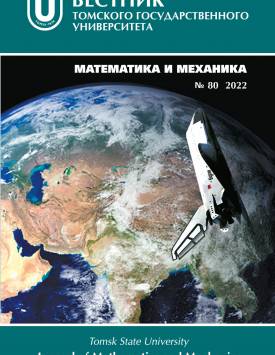Evaluation of local mechanical properties of SiO2-based ceramic refractories using microscale modeling
The development of multiscale mechanical models of promising refractory materials is an urgent problem in the mechanics of solids. One of the reasons is the applicability of these models when creating digital twins of advanced refractories. The authors of this paper recently developed and validated a mesoscopic model of the SiO2-based refractory material that is widely used in metallurgy. This model takes into account the characteristic structural features of SiO2 refractory in the scale range of 10-5 - 10-2 m and the mechanical behavior features in a wide range of strain rates. However, the full use of the model requires knowledge of local mechanical properties of mesoscopic structural elements, in particular, the highly porous regions, which are formed by fine grains less than 102 pm in size. An experimental study of effective mechanical characteristics of such regions is an extremely difficult task. Therefore, the purpose of this work is to obtain the theoretical estimate using the microscale numerical simulation of highly porous regions of SiO2 refractory material and to determine their integral mechanical characteristics. To study this problem, the two-dimensional model samples are developed that simulate fine-grained regions of the refractory and are characterized by different porosity and pore structure types (channel-like or closed type). The intervals of the variation of Young’s modulus and strength characteristics of the samples are obtained depending on the porosity and morphology of the pore space. The contribution of the closed-type porosity to the integral mechanical characteristics of the refractory is determined; though, the volume fraction of such pores is low as compared to that of the channel-like pores. The obtained data will be used as input parameters of mesoscale refractory models for solving the urgent problems related to the study of the effect of microstructure parameters on the macroscopic mechanical and thermomechanical properties of SiO2-based refractories.
Keywords
SiO2-based refractory materials,
porosity,
strength,
numerical modeling,
discrete element methodAuthors
| Grigoriev Aleksandr S. | Institute of Strength Physics and Materials Science of the Siberian Branch of the Russian Academy of Sciences | grigoriev@ispms.ru |
| Dmitriev Andrey I. | Institute of Strength Physics and Materials Science of the Siberian Branch of the Russian Academy of Sciences; Tomsk State University | dmitr@ispms.ru |
| Shil’ko Evgeniy V. | Institute of Strength Physics and Materials Science of the Siberian Branch of the Russian Academy of Sciences; Tomsk State University | shilko@ispms.ru |
Всего: 3
References
Schacht C. Refractory Linings: Thermomechanical Design and Applications. Boca Raton, FL : CRC Press, 2019. 504 р.
Andreev K., Tadaion V., Zhu Q., Wang W., Yin Y., Tonnesen T. Thermal and mechanical cyclic tests and fracture mechanics parameters as indicators of thermal shock resistance - case study on silica refractories // J. Eur. Cer. Soc. 2019. V. 39. P. 1650-1659. doi: 10.1016/j.jeurceramsoc .2018.12.062
Кащеев И.Д., Стрелов К.К., Мамыкин П.С. Химическая технология огнеупоров. М. : Интермет Инжиниринг, 2007. 748 с.
Andreev K., Yin Y., Luchini B., Sabirov I. Failure of refractory masonry material under mono tonic and cyclic loading - Crack propagation analysis // Constr. Build. Mater. 2021. V. 299. Art. 124203. doi: 10.1016/j.conbuildmat.2021.124203
Ozdemir I., Brekelmans W.A.M., Geers M.G.D. Modeling thermal shock damage in refractory materials via direct numerical simulation (DNS) //j. Eur. Ceram. Soc. 2010. V. 30. P. 15851597. doi: 10.1016/j.jeurceramsoc.2009.12.014
Savija B., Smith G.E., Liu D., Schlangen E., Flewitt P.E.J. Modelling of deformation and fracture for a model quasi-brittle material with controlled porosity: Synthetic versus real microstructure // Eng. Fract. Mech. 2019. V. 205. P. 399-417. doi: 10.1016/j.engfracmech.2018.11.008
Andre D., Levraut B., Tessier-Doyen N., Huger M. A discrete element thermo-mechanical modelling of diffuse damage induced by thermal expansion mismatch of two-phase materials // Comput. Methods Appl. Mech. Engrg. 2017. V. 318. P. 898-916. doi: 10.1016/j.cma.2017.01.029
Andreev K., Verstrynge E., Wevers M.Compaction and shear failure of refractory mortars effects of porosity and binder hardening //j. Eur. Ceram. Soc. 2017. V. 37. P. 841-848. doi: 10.1016/j.jeurceramsoc.2016.08.040
Makarian K., Santhanam S. Micromechanical modeling of thermo-mechanical properties of high volume fraction particle-reinforced refractory composites using 3D Finite Element analysis // Ceram.Int. 2020. V. 46. P. 4381-4393. doi: 10.1016/j.ceramint.2019.10.162
Henneberg D., Ricoeur A., Judt P. Multiscale modeling for the simulation of damage processes at refractory materials under thermal shock // Comput. Mater. Sci. 2013. V. 70. P. 187-195. doi: 10.1016/j.commatsci.2013.01.002
Nguyen T.T., Andre D., Huger M. Analytical laws for direct calibration of discrete element modelling of brittle elastic media using cohesive beam model // Comput. Part. Mech. 2019. V. 6. P. 393-409. doi: 10.1007/s40571-018-00221-0
Moreira M.H., Cunha T.M., Campos M.G.G., Santos M.F., Santos Jr. T., Andre D., Pandolfelli V.C. Discrete element modeling - A promising method for refractory microstructure design // Am. Ceram. Soc. Bull. 2020. V. 99 (2). P. 22-28.
Grigoriev A.S., Zabolotskiy A.V., Shilko E.V., Dmitriev A.I., Andreev K. Analysis of the QuasiStatic and Dynamic Fracture of the Silica Refractory Using the Mesoscale Discrete Element Modelling // Materials. 2021. V. 14. Art. 7376. doi: 10.3390/ma14237376
Psakhie S.G., Shilko E. V., Grigoriev A.S., Astafurov S. V., Dimaki A. V., Smolin A.Yu. A mathematical model of particle-particle interaction for discrete element based modeling of deformation and fracture of heterogeneous elastic-plastic materials // Eng. Fract. Mech. 2014. V. 130. P. 96-115. doi: 10.1016/j.engfracmech.2014.04.034
Smolin A.Yu., Roman N.V., Konovalenko I.S., Eremina G.M., Buyakova S.P., Psakhie S.G. 3D simulation of dependence of mechanical properties of porous ceramics on porosity // Eng. Fract. Mech. 2014. V. 130. P. 53-64. doi: 10.1016/j.engfracmech.2014.04.001
Pubst W., Uhlirova T., Gregorova E., Wiegmann A. Young’s modulus and thermal conductivity of model materials with convex or concave pores - from analytical predictions to numerical results //j. Eur. Cer. Soc. 2018. V. 38. P. 2694-2707. doi: 10.1016/j.jeurceramsoc.2018.01.040
Roberts A.P., Garboczi E.J. Elastic properties of model porous ceramics //j. Am. Ceram. Soc. 2000. V. 83. P. 3041-3048. doi: 10.1111/j.1151-2916.2000.tb01680.x

